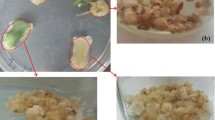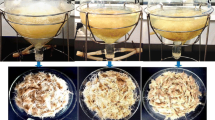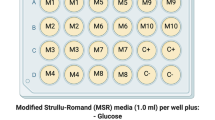Abstract
The composition and content of flavones were estimated in pRi T-DNA-transformed skullcap (Scutellaria baicalensis Georgi) roots obtained by the inoculation of axenically grown seedlings with a wild A4 strain of the soil bacterium Agrobacterium rhizogenes. It was elucidated by analytical and preparative HPLC of phenolic compounds in the extracts from the pRi T-DNA-transformed roots and also by ultraviolet spectroscopy and 1H and 13C NMR that cultured skullcap roots contained similar basic flavones as intact roots of this plant species, i.e., baicalein and wogonin and corresponding glucuronides, baicalin and wogonoside. The content of these flavones in cultured roots was threefold lower than in the roots of intact five-year-old plants. When skullcap roots were cultured on B5 or Murashige and Skoog medium, the ratios between major flavones changed but their total content remained unchanged. The treatment of three-week-old cultured roots with methyl ether of jasmonic acid (MeJa) doubled the total concentration of major flavones in roots; the content of aglycons, baicalein and wogonin, increased to a greater degree, e.g., by 2.3 and 3.3 times, respectively. The induction of flavone production by elicitors indicates that flavones behave as phytoanticipins because major flavones of skullcap manifest a distinct antimicrobial activity. The results of the short-term treatment of skullcap roots with MeJa show that stress biotic factors can considerably increase the content of physiologically active flavones.
Similar content being viewed by others
Abbreviations
- DMSO:
-
dimethyl sulfoxide
- EA:
-
ethyl acetate
- MeJa:
-
methyl jasmonate
- MS:
-
Murashige and Skoog nutrient medium
- TFA:
-
trifluoroacetic acid
- UV:
-
ultraviolet
REFERENCES
D. Tepfer (1983) Biology of Genetical Transformation of Plant with Agrobacterium rhizogenes A. Pühler (Eds) Molecular Genetics of the Bacteria-Plant Interaction Springer-Verlag Berlin 272–293
M.C. Christey (2001) ArticleTitleInvited Review: Use of Ri-Mediated Transformation for Production of Transgenic Plants In Vitro Cell Dev. Biol. Plant. 37 687–700
H. Wysokinska A. Chimel (1997) ArticleTitleTransformed Root Cultures for Biotechnology Acta Biotechnol. 17 131–159
A. Giri M.L. Narasu (2001) ArticleTitleTransgenic Hairy Roots: Recent Trend and Applications Biotech. Adv. 18 1–22
A.M. Smirnov (1970) Rost i metabolizm izolirovannykh kornei v steril’noi kul’ture Nauka Moscow
N. Joshee T.S. Patrick R.S. Mentreddy A.K. Yadav (2002) Skullcap: Potential Medicinal Crop J. Janick A. Whipkey (Eds) Trends in New Crops and New Uses ASHS Press Alexandria 580–586
I.N. Kuzovkina A.V. Guseva I.E. Al’terman R.A. Karnachuk (2001) ArticleTitleFlavonoid Production in Transformed Scutellaria baicalensis Roots and Ways of Its Regulation Fiziol. Rast. 48 523–528
O.L. Gamborg R.A. Miller K. Ojima (1968) ArticleTitleNutrient Requirements of Suspension Cultures of Soybean Root Cells Exp. Cell Res. 50 151–158
T. Murashige F. Skoog (1962) ArticleTitleA Revised Medium for Rapid Growth and Bioassay with Tobacco Tissue Physiol. Plant. 15 473–479
Y. Miyaichi Y. Imoto T. Tomimori C.-C. Lin (1987) ArticleTitleStudies on the Constituents of Scutellaria Species: 9. On the Flavonoid Constituents of the Root of Scutellaria indica L. Chem. Pharm. Bull. 35 3720–3725
T. Horie Y. Ohtsuru K. Shibata K. Yamashita M. Tsukayama Y. Kamamura (1998) ArticleTitle 13C NMR Spectral Assignment of the A-Ring of Polyoxygenated Flavones Phytochemistry 47 865–874
D. Wozniak E. Lamer-Zagawska A. Matkowski (2004) ArticleTitleAntimutagenic and Antiradical Properties of Flavones from the Roots of Scutellaria baicalensis Georgi Nährung. 48 9–12
S. Maki N. Tadashu M. Yoshizumi M. Masataka (2004) ArticleTitleCytotoxic Activities of Flavonoinds from Two Scutellaria Plants in Chinese Medicine J. Ethnopharmacol. 91 65–68
Y. Zhou M. Hirotani T. Furuya (1997) ArticleTitleFlavonoids and Phenylethanoids from Hairy Root Culture of Scutellaria baicalensis Phytochemistry 44 83–87 Occurrence Handle10.1016/S0031-9422(96)00443-8 Occurrence Handle1:CAS:528:DyaK2sXhsVWjsg%3D%3D
K. Nishikawa K. Ishimaru (1997) ArticleTitleFlavonoids in Root Cultures of Scutellaria baicalensis J. Plant Physiol. 151 633–636
K. Nishikawa H. Furukawa F. Toshihiro H. Fujii K. Mihashi K. Shimomura K. Isjimaru (1999) ArticleTitleFlavone Production in Transformed Root Cultures of Scutellaria baicalensis Georgi Phytochemistry 52 885–890 Occurrence Handle10.1016/S0031-9422(99)00306-4 Occurrence Handle1:CAS:528:DC%2BD3cXhtFCjtA%3D%3D
M. Hirotani (1999) Genetical Transformation of Scutellaria baicalensis, Biotechnology in Agriculture and Foresty Y.P.S. Bajaj (Eds) Transgenic Medicinal Plants Springer-Verlag Berlin 272–283
A. Stojakowska J. Malarz (2000) ArticleTitleFlavonoid Production in Transformed Root Cultures of Scutellaria baicalensis J. Plant Physiol. 156 121–125
Gy. Kovács I.N. Kuzovkina É. Szöke L. Kursinzki (2004) ArticleTitleHPLC Determination of Flavonoids in Hairy-Root Cultures of Scutellaria baicalensis Georgi Chromatographia 60 81–85
H.D. Etten ParticleVan J.W. Mansfield J.A. Bailey E.E. Farmer (1994) ArticleTitleTwo Classes of Plant Antibiotics: Phytoalexins versus Phytoanticipins Plant Cell 6 1191–1192
S. Morimoto N. Tateishi T. Matsuda H. Tanaka F. Taura N. Furuya N. Matsuyama Y. Shoyama (1998) ArticleTitleNovel Hydrogen Peroxide Metabolism in Suspension Culture of Scutellaria baicalensis Georgi J. Biol. Chem. 273 12606–12611
H.C. Huang H.R. Wang L.M. Hsieh (1994) ArticleTitleAntiproliferative Effect of Baicalein, a Flavonoid from a Chinese Herb, on Vascular Smooth Muscle Cell Eur. J. Pharmacol. 251 91–93
Y.S. Chi H. Lim H. Park H.P. Kim (2003) ArticleTitleEffect of Wogonin, a Plant Flavone from Scutellaria baicalensis Radix, on Skin Inflammation: In Vivo Regulation of Inflammation-Associated Gene Expression Biochem. Pharmacol. 66 1271–1278
D.Y. Zang J. Wu F. Ye L. Xue S. Jiang J. Yi W. Zhang H. Wei M. Sung W. Wang X. Li (2003) ArticleTitleInhibition of Cancer Cell Proliferation and Prostaglandin E2 Synthesis by Scutellaria baicalensis Cancer Res. 63 4037–4043
Author information
Authors and Affiliations
Additional information
Translated from Fiziologiya Rastenii, Vol. 52, No. 1, 2005, pp. 90–96.
Original Russian Text Copyright © 2005 by Kuzovkina, Guseva, Kovács, Szöke, Vdovitchenko.
Rights and permissions
About this article
Cite this article
Kuzovkina, I.N., Guseva, A.V., Kovács, D. et al. Flavones in genetically transformed Scutellaria baicalensis roots and induction of their synthesis by elicitation with methyl jasmonate. Russ J Plant Physiol 52, 77–82 (2005). https://doi.org/10.1007/s11183-005-0012-y
Received:
Issue Date:
DOI: https://doi.org/10.1007/s11183-005-0012-y




